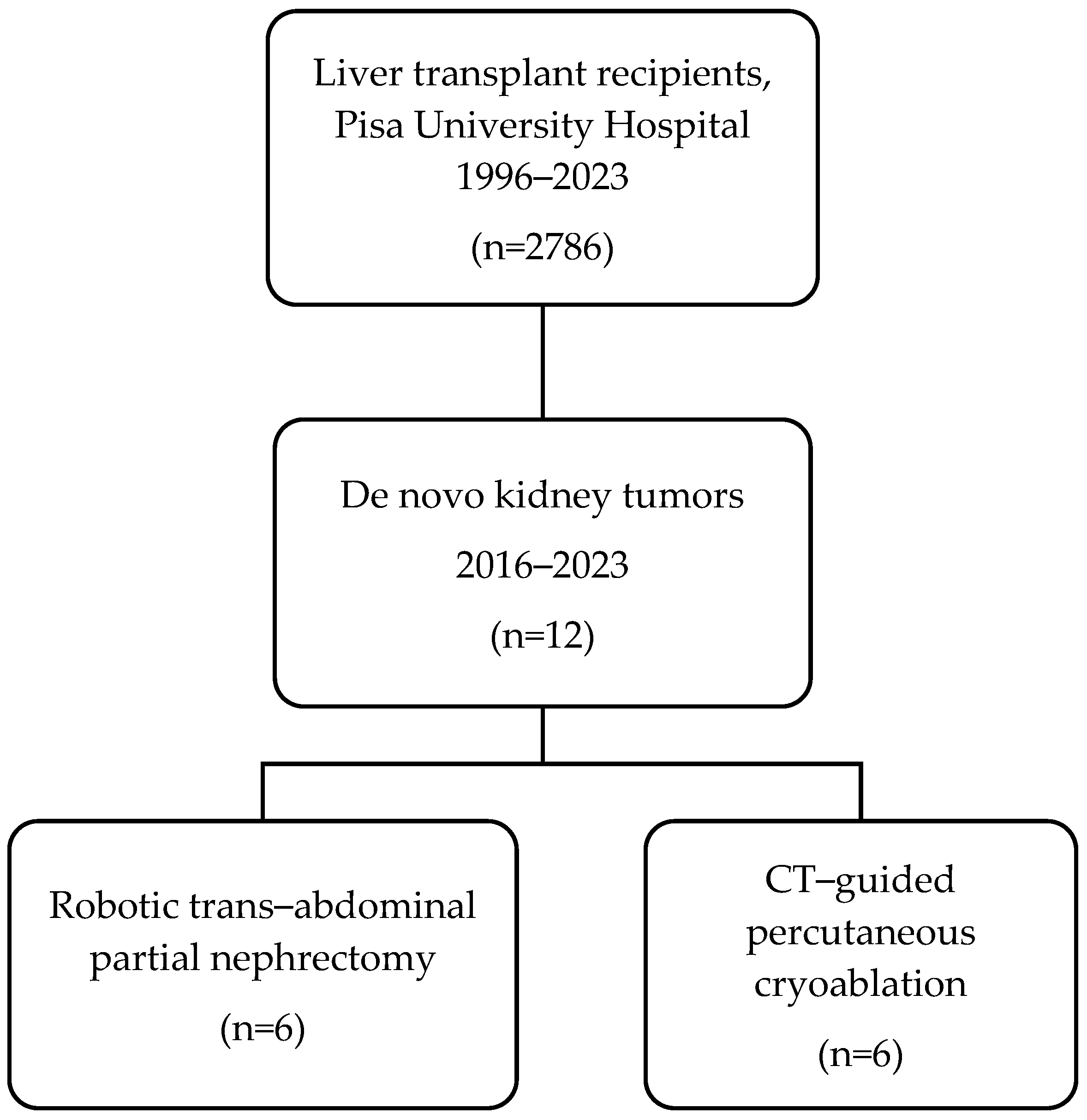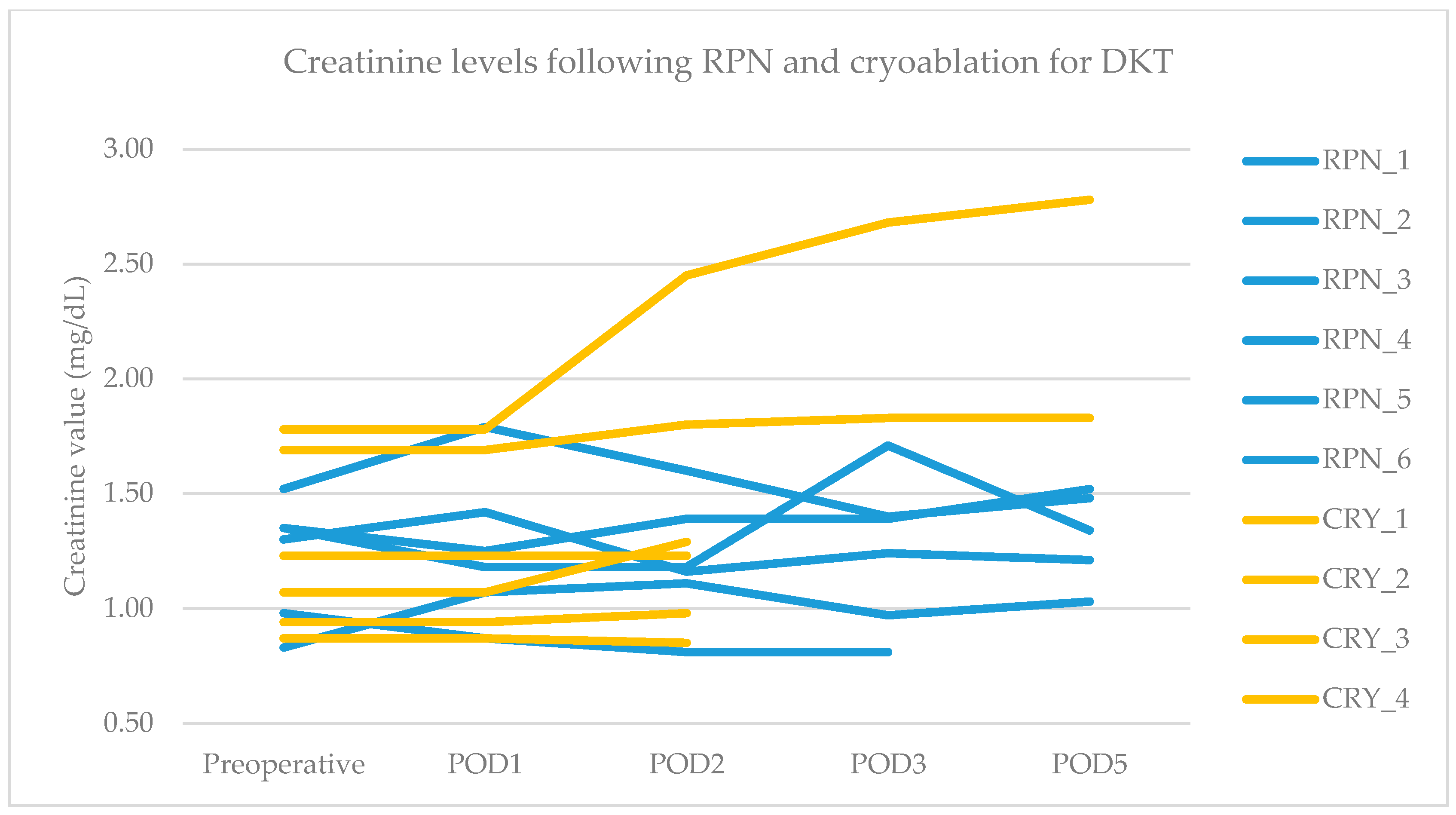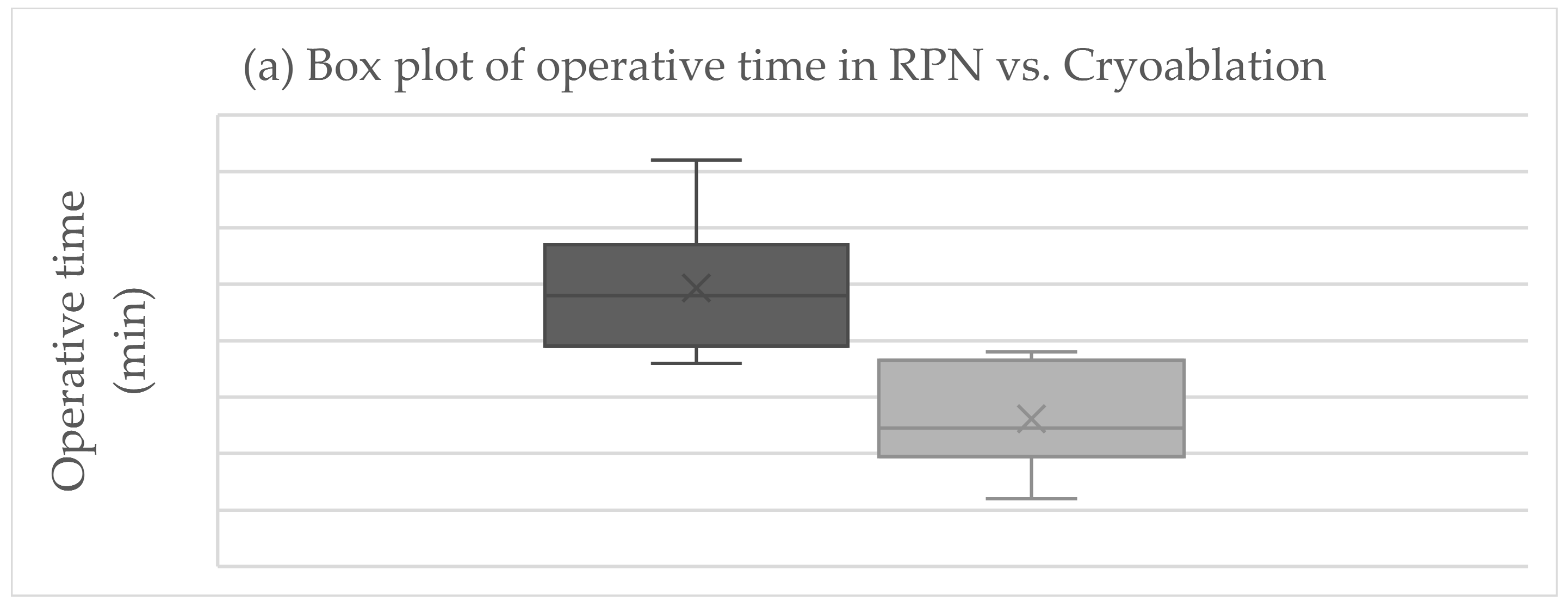Transabdominal Robotic-Assisted Partial Nephrectomy and CT-Guided Percutaneous Cryoablation for the Treatment of De Novo Kidney Tumors After Liver Transplantation
Abstract
1. Introduction
2. Materials and Methods
2.1. Study Design and Setting
2.2. Participants
2.3. Data Source and Outcome
2.4. Indications to Surgery or Cryoablation
2.5. Procedures and Follow-Up
2.6. Statistical Analysis
3. Results
3.1. Participants
3.2. Efficacy and Safety
3.3. Costs
3.4. Oncologic Efficacy (Recurrence and Survival)
4. Discussion
5. Conclusions
Supplementary Materials
Author Contributions
Funding
Institutional Review Board Statement
Informed Consent Statement
Data Availability Statement
Conflicts of Interest
References
- Burra, P. Neoplastic disease after liver transplantation: Focus on de novo neoplasms. World J. Gastroenterol. 2015, 21, 8753. [Google Scholar] [CrossRef]
- Burra, P.; Shalaby, S.; Zanetto, A. Long-term care of transplant recipients: De novo neoplasms after liver transplantation. Curr. Opin. Organ Transplant. 2018, 23, 187–195. [Google Scholar] [CrossRef]
- Dharia, A.; Boulet, J.; Sridhar, V.S.; Kitchlu, A. Cancer Screening in Solid Organ Transplant Recipients: A Focus on Screening Liver, Lung, and Kidney Recipients for Cancers Related to the Transplanted Organ. Transplantation 2022, 106, e64–e65. [Google Scholar] [CrossRef] [PubMed]
- Colmenero, J.; Tabrizian, P.; Bhangui, P.; Pinato, D.J.; Rodríguez-Perálvarez, M.L.; Sapisochin, G.; Bhoori, S.; Pascual, S.; Senzolo, M.; Al-Adra, D.; et al. De Novo Malignancy After Liver Transplantation: Risk Assessment, Prevention, and Management—Guidelines From the ILTS-SETH Consensus Conference. Transplantation 2022, 106, e30–e45. [Google Scholar] [CrossRef] [PubMed]
- Zhu, X.; Wang, J.; Zhang, Y.; Xu, M.; Chen, P.; Wang, C. Risk of renal cancer in liver transplant recipients: A systematic review and meta-analysis. Int. J. Surg. 2016, 25, 128–133. [Google Scholar] [CrossRef] [PubMed]
- Manzia, T.M.; Angelico, R.; Gazia, C.; Lenci, I.; Milana, M.; Ademoyero, O.T.; Pedini, D.; Toti, L.; Spada, M.; Tisone, G.; et al. De novo malignancies after liver transplantation: The effect of immunosuppressionn-personal data and review of literature. World J. Gastroenterol. 2019, 25, 5356–5375. [Google Scholar] [CrossRef] [PubMed]
- Gitto, S.; Magistri, P.; Marzi, L.; Mannelli, N.; De Maria, N.; Mega, A.; Vitale, G.; Valente, G.; Vizzutti, F.; Villa, E.; et al. Predictors of solid extra-hepatic non-skin cancer in liver transplant recipients and analysis of survival: A long-term follow-up study. Ann. Hepatol. 2022, 27, 100683. [Google Scholar] [CrossRef]
- Saglam, K.; Sahin, T.T.; Ogut, Z.; Ince, V.; Usta, S.; Yilmaz, S. De Novo Malignancies After Liver Transplantation: Experience of a High-Volume Center. J. Gastrointest. Cancer 2022, 53, 1020–1027. [Google Scholar] [CrossRef]
- Kobayashi, T.; Miura, K.; Ishikawa, H.; Sakata, J.; Takizawa, K.; Hirose, Y.; Toge, K.; Saito, S.; Abe, S.; Kawachi, Y.; et al. Malignancy After Living Donor Liver Transplantation. Transplant. Proc. 2024, 56, 660–666. [Google Scholar] [CrossRef] [PubMed]
- Ojo, A.O.; Held, P.J.; Port, F.K.; Wolfe, R.A.; Leichtman, A.B.; Young, E.W.; Arndorfer, J.; Christensen, L.; Merion, R.M. Chronic Renal Failure after Transplantation of a Nonrenal Organ. N. Engl. J. Med. 2003, 349, 931–940. [Google Scholar] [CrossRef] [PubMed]
- Ume, A.C.; Wenegieme, T.Y.; Williams, C.R. Calcineurin inhibitors: A double-edged sword. Am. J. Physiol. Physiol. 2021, 320, F336–F341. [Google Scholar] [CrossRef] [PubMed]
- Ljungberg, B.; Albiges, L.; Abu-Ghanem, Y.; Bedke, J.; Capitanio, U.; Dabestani, S.; Fernández-Pello, S.; Giles, R.H.; Hofmann, F.; Hora, M.; et al. European Association of Urology Guidelines on Renal Cell Carcinoma: The 2022 Update. Eur. Urol. 2022, 82, 399–410. [Google Scholar] [CrossRef] [PubMed]
- Powles, T.; Albiges, L.; Bex, A.; Comperat, E.; Grünwald, V.; Kanesvaran, R.; Kitamura, H.; McKay, R.; Porta, C.; Procopio, G.; et al. Renal cell carcinoma: ESMO Clinical Practice Guideline for diagnosis, treatment and follow-up. Ann. Oncol. 2024, 35, 692–706. [Google Scholar] [CrossRef] [PubMed]
- Hinata, N.; Shiroki, R.; Tanabe, K.; Eto, M.; Takenaka, A.; Kawakita, M.; Hara, I.; Hongo, F.; Ibuki, N.; Nasu, Y.; et al. Robot-assisted partial nephrectomy versus standard laparoscopic partial nephrectomy for renal hilar tumor: A prospective multi-institutional study. Int. J. Urol. 2021, 28, 382–389. [Google Scholar] [CrossRef] [PubMed]
- Ruiz Guerrero, E.; Claro, A.V.O.; Ledo Cepero, M.J.; Soto Delgado, M.; Álvarez-Ossorio Fernández, J.L. Robotic versus Laparoscopic Partial Nephrectomy in the New Era: Systematic Review. Cancers 2023, 15, 1793. [Google Scholar] [CrossRef]
- Wang, L.; Deng, J.; Liang, C.; Zhu, P. Perioperative, functional, and oncological outcomes of robotic vs. laparoscopic partial nephrectomy for complex renal tumors (RENAL score ≥7): An evidence-based analysis. Front. Oncol. 2023, 13, 1195910. [Google Scholar] [CrossRef]
- Sucandy, I.; Shapera, E.; Crespo, K.; Syblis, C.; Przetocki, V.; Ross, S.; Rosemurgy, A. The effect of the robotic platform in hepatectomy after prior liver and non-liver abdominal operations: A comparative study of clinical outcomes. J. Robot. Surg. 2021, 16, 1067–1072. [Google Scholar] [CrossRef] [PubMed]
- Colasanti, M.; Berardi, G.; Mariano, G.; Ferretti, S.; Meniconi, R.L.; Guglielmo, N.; Ettorre, G.M. Laparoscopic Left Hepatectomy for Hepatocellular Carcinoma Recurrence Following Liver Transplantation. Ann. Surg. Oncol. 2022, 29, 2984. [Google Scholar] [CrossRef]
- Birgin, E.; Abdelhadi, S.; Seyfried, S.; Rasbach, E.; Rahbari, M.; Téoule, P.; Reißfelder, C.; Rahbari, N.N. Robotic or laparoscopic repeat hepatectomy after open hepatectomy: A cohort study. Surg. Endosc. 2024, 38, 1296–1305. [Google Scholar] [CrossRef]
- Neves, J.B.; Warren, H.; Santiapillai, J.; Rode, N.; Cullen, D.; Pavlou, M.; Walkden, M.; Patki, P.; Barod, R.; Mumtaz, F.; et al. Nephron Sparing Treatment (NEST) for Small Renal Masses: A Feasibility Cohort-embedded Randomised Controlled Trial Comparing Percutaneous Cryoablation and Robot-assisted Partial Nephrectomy. Eur. Urol. 2024, 85, 333–336. [Google Scholar] [CrossRef] [PubMed]
- Wu, X.; Uhlig, J.; Shuch, B.M.; Uhlig, A.; Kim, H.S. Cost-effectiveness of minimally invasive partial nephrectomy and percutaneous cryoablation for cT1a renal cell carcinoma. Eur. Radiol. 2022, 33, 1801–1811. [Google Scholar] [CrossRef] [PubMed]
- Yeaman, C.; Marchant, R.; Lobo, J.M.; DeNovio, A.; O’connor, L.; Wanchek, T.; Ballantyne, C.; Lambert, D.L.; Mithqal, A.; Schenkman, N. Cost-effectiveness analysis: Percutaneous microwave ablation vs robotic-assisted partial nephrectomy for small renal masses. Abdom. Radiol. 2022, 48, 411–417. [Google Scholar] [CrossRef]
- Von Elm, E.; Altman, D.G.; Egger, M.; Pocock, S.J.; Gøtzsche, P.C.; Vandenbroucke, J.P. The Strengthening the Reporting of Observational Studies in Epidemiology (STROBE) Statement: Guidelines for reporting observational studies. Int. J. Surg. 2014, 12, 1495–1499. [Google Scholar] [CrossRef] [PubMed]
- Kutikov, A.; Uzzo, R.G. The R.E.N.A.L. Nephrometry Score: A Comprehensive Standardized System for Quantitating Renal Tumor Size, Location and Depth. J. Urol. 2009, 182, 844–853. [Google Scholar] [CrossRef] [PubMed]
- Dindo, D.; Demartines, N.; Clavien, P.A. Classification of Surgical Complications: A New Proposal With Evaluation in a Cohort of 6336 Patients and Results of a Survey. Ann. Surg. 2004, 240, 205–213. [Google Scholar] [CrossRef] [PubMed]
- Balzano, E.; Bernardi, L.; Roesel, R.; Vagelli, F.; Ghinolfi, D.; Tincani, G.; Catalano, G.; Melandro, F.; Petrusic, A.; Popeskou, S.-G.; et al. Robotic versus laparoscopic liver resections: Propensity-matched comparison of two-center experience. Surg. Endosc. 2023, 37, 8123–8132. [Google Scholar] [CrossRef]
- Bernardi, L.; Balzano, E.; Roesel, R.; Ghinolfi, D.; Vagelli, F.; Menconi, G.; Petrusic, A.; Mongelli, F.; Majno-Hurst, P.; De Simone, P.; et al. Concomitant training in robotic and laparoscopic liver resections of low-to-intermediate difficulty score: A retrospective analysis of the learning curve. Sci. Rep. 2024, 14, 3595. [Google Scholar] [CrossRef] [PubMed]
- De Martin, E.; Berg, T.; Berenguer, M.; Burra, P.; Fondevila, C.; Heimbach, J.K.; Pageaux, G.-P.; Sanchez-Fueyo, A.; Toso, C. EASL Clinical Practice Guidelines on liver transplantation. J. Hepatol. 2024, 81, 1040–1086. [Google Scholar] [CrossRef]
- Lehrer, R.; Cornelis, F.; Bernhard, J.C.; Bigot, P.; Champy, C.; Bruyère, F.; Rouprêt, M.; Doumerc, N.; Bensalah, C.-K.; Olivier, J.; et al. Minimally invasive nephron-sparing treatments for T1 renal cell cancer in patients over 75 years: A comparison of outcomes after robot-assisted partial nephrectomy and percutaneous ablation. Eur. Radiol. 2023, 33, 8426–8435. [Google Scholar] [CrossRef] [PubMed]
- Emara, A.M.; Kommu, S.S.; Hindley, R.G.; Barber, N.J. Robot-assisted partial nephrectomy vs laparoscopic cryoablation for the small renal mass: Redefining the minimally invasive ‘gold standard’. BJU Int. 2014, 113, 92–99. [Google Scholar] [CrossRef][Green Version]
- Bourgi, A.; Ayoub, E.; Merhej, S.; Souky, J.; Roupret, M.; Bruyère, F. A comparison of perioperative outcomes of transperitoneal versus retroperitoneal robot-assisted partial nephrectomy: A systematic review. J. Robot. Surg. 2023, 17, 2563–2574. [Google Scholar] [CrossRef] [PubMed]
- Balzano, E.; Bernardi, L.; Tincani, G.; Ghinolfi, D.; Melandro, F.; Bronzoni, J.; Meli, S.; Arenga, G.; Biancofiore, G.; Crocetti, L.; et al. Implementing a robotic liver resection program does not always require prior laparoscopic experience. Surg. Endosc. 2022, 36, 3317–3322. [Google Scholar] [CrossRef] [PubMed]
- Psutka, S.P.; Feldman, A.S.; McDougal, W.S.; McGovern, F.J.; Mueller, P.; Gervais, D.A. Long-Term Oncologic Outcomes After Radiofrequency Ablation for T1 Renal Cell Carcinoma. Eur. Urol. 2013, 63, 486–492. [Google Scholar] [CrossRef] [PubMed]
- Morkos, J.; Porosnicu Rodriguez, K.A.; Zhou, A.; Kolarich, A.R.; Frangakis, C.; Rodriguez, R.; Georgiades, C.S. Percutaneous Cryoablation for Stage 1 Renal Cell Carcinoma: Outcomes from a 10-year Prospective Study and Comparison with Matched Cohorts from the National Cancer Database. Radiology 2020, 296, 452–459. [Google Scholar] [CrossRef] [PubMed]
- Yu, J.; Zhang, X.; Liu, H.; Zhang, R.; Yu, X.; Cheng, Z.; Han, Z.; Liu, F.; Hao, G.; Mu, M.-J.; et al. Percutaneous Microwave Ablation versus Laparoscopic Partial Nephrectomy for cT1a Renal Cell Carcinoma: A Propensity-matched Cohort Study of 1955 Patients. Radiology 2020, 294, 698–706. [Google Scholar] [CrossRef] [PubMed]





| RPN (n = 6) | Cryoablation (n = 6) | p | |
|---|---|---|---|
| Sex male, n (%) | 5 (83.3) | 6 (100) | 1.0 |
| Age (years), mean (SD) | 61.0 (4.3) | 68.7 (8.4) | 0.07 |
| BMI (kg/m2), mean (SD) | 25.6 (1.6) | 23.4 (1.3) | 0.69 |
| Liver disease prior to LT, n (%) | |||
| HBV/HCV | 5 (83.3) | 5 (83.3) | 1.0 |
| OH | 1 (16.7) | 0 (0) | |
| PSC | 0 (0) | 1 (16.7) | |
| Indication to LT, n (%) | |||
| Advanced cirrhosis | 4 (66.7) | 3 (50.0) | 0.64 |
| HCC | 1 (16.7) | 3 (50) | |
| Acute hepatitis | 1 (16.7) | 0 (0) | |
| Interval between LT and DKT diagnosis (months), median (IQR) | 142.5 (107.5–180.5) | 117.5 (62.5–180.0) | 0.57 |
| Immunosuppressive regime at DKT diagnosis, n (%) | |||
| Tacrolimus | 3 (50) | 3 (50) | 1.0 |
| Everolimus | 1 (16.7) | 2 (33.3) | |
| Ciclosporin | 2 (33.3) | 0 (0) | |
| Mycophenolate | 0 (0) | 1 (16.7) | |
| DKT size (mm), mean (SD) | 25.3 (10.6) | 23.8 (10.3) | 0.81 |
| Side of DKT, n (%) | |||
| Right | 3 (50) | 1 (16.7) | 0.47 |
| Left | 3 (50) | 5 (83.3) | |
| Location of DKT, n (%) | |||
| Polar superior | 1 (16.7) | 1 (16.7) | 0.92 |
| Polar inferior | 4 (66.7) | 3 (50) | |
| Meso-renal | 1 (16.7) | 2 (33.3) | |
| Anterior | 3 (50) | 0 (0) | NA |
| Posterior | 3 (50) | 6 (100) | |
| Pre-procedural biopsy, n (%) | 0 (0) | 0 (0) | NA |
| RENAL score [24], mean (SD) | 7.4 (2.2) | 5.5 (1.2) | 0.10 |
| T stage, n (%) | |||
| T1a | 5 (83.3) | 5 (83.3) | 1.0 |
| T1b | 1 (16.7) | 1 (16.7) | |
| Baseline creatinine value (mg/dL), mean (SD) | 1.26 (0.31) | 1.26 (0.38) | 1.0 |
| RPN (n = 6) | Cryoablation (n = 6) | p | |
|---|---|---|---|
| Operative time (min), mean (SD) | 247 (63.0) | 131 (48) | 0.01 |
| Intraoperative complications, n (%) | 1 (16.7) | 0 (0) | NA |
| Conversions to open surgery, n (%) | 1 (16.7) | – | |
| Postoperative morbidity (CD), n (%) | 1 (16.7) | 1 (16.7) | 1.0 |
| Postoperative major morbidity (CD III or more), n (%) | 0 (0) | 0 (0) | NA |
| Hospital stay (days), mean (SD) | 6.7 (2.2) | 3.1 (3.0) | 0.03 |
| Pathology, n (%) | |||
| papillary type renal cell carcinoma | 5 (83.3) | – | |
| negative for malignancy | 1 (16.7) | – | |
| Technical efficacy, n (%) | 6 (100) | 6 (100) | 1.0 |
| R0 margin | 6 (100) | – | |
| Absence of viable tumor at 1st follow-up imaging | – | 6 (100) | |
| Procedure-related mortality, n (%) | 0 (0) | 0 (0) | |
| Periprocedural costs (EUR) per patient, mean (SD) | 13,586.0 (860.0) | 6792.0 (1230.0) | 0.01 |
| Follow-up duration (months), median (IQR) | 49.5 (41.5–55.7) | 20.5 (12.2–38.5) | <0.001 |
| Patients alive at last follow-up, n (%) | 6 (100) | 6 (100) | 1.0 |
| Recurrence, n (%) | 0 (0) | 0 (0) | NA |
Disclaimer/Publisher’s Note: The statements, opinions and data contained in all publications are solely those of the individual author(s) and contributor(s) and not of MDPI and/or the editor(s). MDPI and/or the editor(s) disclaim responsibility for any injury to people or property resulting from any ideas, methods, instructions or products referred to in the content. |
© 2025 by the authors. Licensee MDPI, Basel, Switzerland. This article is an open access article distributed under the terms and conditions of the Creative Commons Attribution (CC BY) license (https://creativecommons.org/licenses/by/4.0/).
Share and Cite
Balzano, E.; Bernardi, L.; Candita, G.; Trizzino, A.; Petagna, L.; Bozzi, E.; Scalise, P.; Cristaudi, A.; Tincani, G.; Pezzati, D.; et al. Transabdominal Robotic-Assisted Partial Nephrectomy and CT-Guided Percutaneous Cryoablation for the Treatment of De Novo Kidney Tumors After Liver Transplantation. Life 2025, 15, 254. https://doi.org/10.3390/life15020254
Balzano E, Bernardi L, Candita G, Trizzino A, Petagna L, Bozzi E, Scalise P, Cristaudi A, Tincani G, Pezzati D, et al. Transabdominal Robotic-Assisted Partial Nephrectomy and CT-Guided Percutaneous Cryoablation for the Treatment of De Novo Kidney Tumors After Liver Transplantation. Life. 2025; 15(2):254. https://doi.org/10.3390/life15020254
Chicago/Turabian StyleBalzano, Emanuele, Lorenzo Bernardi, Gianvito Candita, Arianna Trizzino, Lorenzo Petagna, Elena Bozzi, Paola Scalise, Alessandra Cristaudi, Giovanni Tincani, Daniele Pezzati, and et al. 2025. "Transabdominal Robotic-Assisted Partial Nephrectomy and CT-Guided Percutaneous Cryoablation for the Treatment of De Novo Kidney Tumors After Liver Transplantation" Life 15, no. 2: 254. https://doi.org/10.3390/life15020254
APA StyleBalzano, E., Bernardi, L., Candita, G., Trizzino, A., Petagna, L., Bozzi, E., Scalise, P., Cristaudi, A., Tincani, G., Pezzati, D., Ghinolfi, D., & Crocetti, L. (2025). Transabdominal Robotic-Assisted Partial Nephrectomy and CT-Guided Percutaneous Cryoablation for the Treatment of De Novo Kidney Tumors After Liver Transplantation. Life, 15(2), 254. https://doi.org/10.3390/life15020254







